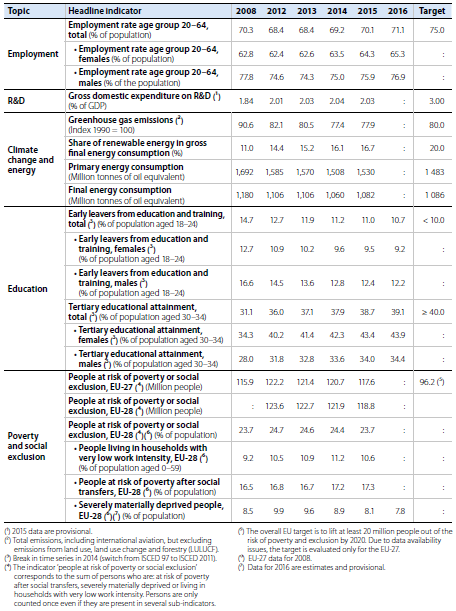This article presents a statistical view of the Europe 2020 strategy of the European Union (EU), aimed at creating a smarter, greener and more inclusive economy and society. Eurostat, the statistical office of the EU, has created eight headline indicators and three sub-indicators to monitor progress towards the strategy targets. A comprehensive overview of available data can be found in the online publication Smarter, greener, more inclusive - indicators to support the Europe 2020 strategy, also downloadable as PDF file.
The Europe 2020 strategy
As a leading provider of official statistics on the European Union (EU) and in response to the growing interest in data on the Europe 2020 strategy, Eurostat produces and disseminates statistical data to support the strategy. Progress towards the Europe 2020 targets is monitored by means of nine headline indicators and additional sub-indicators. Data on the headline indicators are disseminated through a Dedicated section on the Eurostat website.
In late 2013, Eurostat introduced a new type of ‘flagship publication’ with the aim of providing statistical analyses related to important European Commission policy frameworks or important economic, social or environmental phenomena. The purpose of the first of these flagship publications – entitled ‘Smarter, greener, more inclusive? — Indicators to support the Europe 2020 strategy’ – was to provide statistical support for the Europe 2020 strategy and to back-up the monitoring of its headline targets. Updated editions were published in 2015, 2016 adn 2017, looking into past trends, generally since 2002 or 2008, up to the most recent year for which data are available.
The Europe 2020 strategy, adopted by the European Council on 17 June 2010, is the EU’s agenda for growth and jobs for the current decade. It emphasises smart, sustainable and inclusive growth as a way to overcome the structural weaknesses in Europe’s economy, improve its competitiveness and productivity and underpin a sustainable social market economy.
The key objectives of the Europe 2020 strategy are expressed in the form of five headline targets at the EU level:
- Increasing the employment rate of the population aged 20-64 to at least 75 %.
- Increasing combined public and private investment in R&D to 3 % of GDP.
- Climate change and energy targets:
- Reducing greenhouse gas emissions by at least 20 % compared to 1990 levels.
- Increasing the share of renewable energy in final energy consumption to 20 %.
- Moving towards a 20 % increase in energy efficiency.
- Reducing school drop-out rates to less than 10 % and increasing the share of the population aged 30-34 having completed tertiary education to at least 40 %.
- Lifting at least 20 million people out of the risk of poverty and social exclusion.
The EU headline targets have been translated into national targets, as defined in the National Reform Programmes. These reflect each Member State’s situation and the level of ambition they are able to reach as part of the EU-wide effort for implementing the Europe 2020 strategy.
See also
- Articles on sustainable development indicators
- Employment statistics
- Energy production and imports
- Greenhouse gas emission statistics
- Renewable energy statistics
- Early leavers from education and training
- Smarter, greener, more inclusive - indicators to support the Europe 2020 strategy
Further Eurostat information
Publications
- Smarter, greener, more inclusive - indicators to support the Europe 2020 strategy (online publication, also downloadable as PDF file)
Main tables
Dedicated section
Methodology / Metadata
- Towards robust quality management for European Statistics - Communication from the Commission to the European Parliament and the Council COM(2011) 211 final.
Other information
- Regulation (EC) No 223/2009 of 11 March 2009 on European statistics

